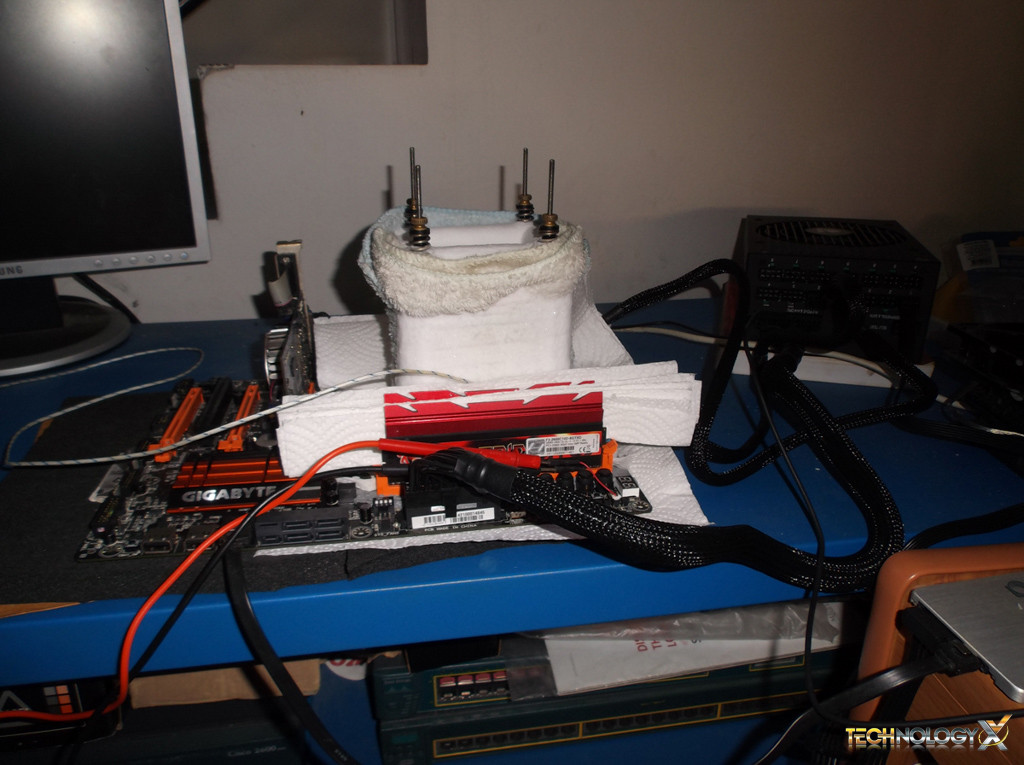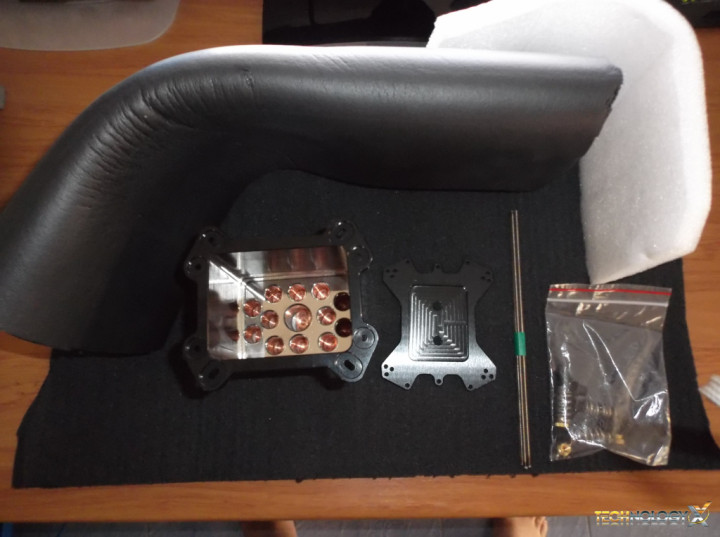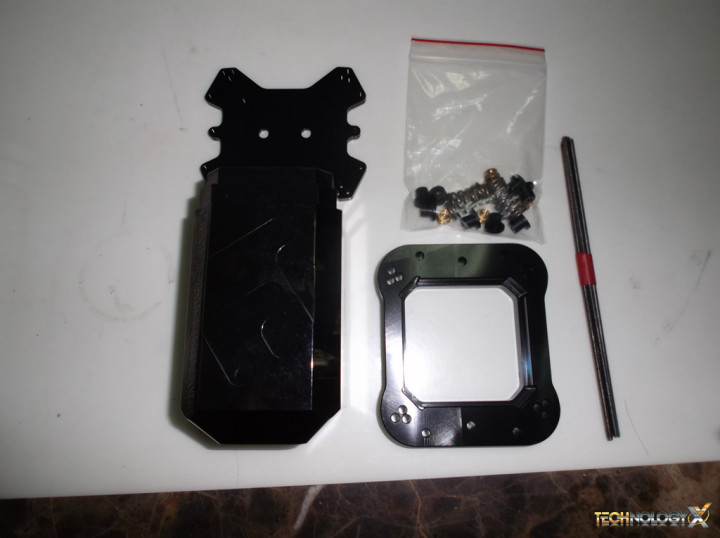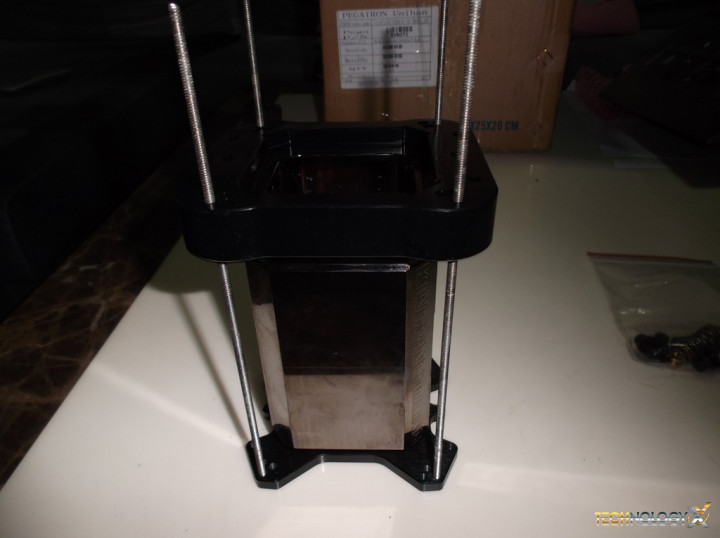If you are reading this, then maybe you are ready to make the jump into subzero benchmarking or just interested in a simple how to. Subzero benchmarking is where you use LN2 (Liquid Nitrogen), DICE (Dry Ice), Phase change units or even, for those daring enough, LHE (Liquid Helium). The main focus of this guide is to show you what you need to start of on LN2 or DICE. We will look at what is needed and some terminology on CPU and Graphics subzero overclocking and benchmarking.
We will not be doing any actual subzero overclocking and benchmarking, as they will be covered in future articles in our Subzero Series in. We previously posted an article showing you a comparison between standard cooling and LN2.
GETTING STARTED
To get started you will need the following items:
- Hardware
- CPU LN2/DICE pot
- Insulation Materials
- LN2/DICE Supplier
For computer hardware, older generation is a cheap fun way to start. For example a nice P45 or X48 LGA775 board and a bunch of Core 2, Celeron D and Pentium sck775 CPU’s, which if you search eBay or technology sites, you’ll be surprised what you can find. This goes the same for AMD, such as AM2 and AM3 hardware. The main point here is that you dont need the latest and best hardware on the market to start Subzero Benchmarking.
CPU AND GPU POTS
There are numerous pot manufacturers out there, such as der8auer and Kingpin. New pots can be expensive, so you might want to check out technology sites and marketplaces for someone selling used pots. The pots we will look at are from Kingpin Cooling, as we have found these pots professionally made and can do the job well. Pots from der8auer are of great quality as well and are not to be dismissed.
First we will start with some terminology on cold bugs.
COLDBUG AND COLD BOOT BUG
Because Intel CPU’s suffer from what is known as Coldbug (CB) and Cold Boot Bug (CBB), these temperatures must be monitored constantly with a digital thermometer and a K-Type bead probe, which all LN2 pots have a hole at the base to insert the probe. AMD CPU’s can handle what is known as a full pot, by that I mean they do not suffer from these bugs and can handle temps to -196C, which is the boiling point of Liquid Nitrogen in an ideal situation. Around -180C approx is roughly the boiling point on Liquid Nitrogen at sea level. CB and CBB can vary from chip to chip although the delta between the two is pretty close. When a CPU hits its CB point, the system will shutdown whilst with CBB the CPU will not allow booting due to cold. To warm the pot up a hand held blow torch is used and is what is known as pulling the pot up. To get temperatures back down, LN2 is poured which is known as pulling the pot down.
THE VENOM 6.66 POT
This pot is what is known as a fast pot, this means you can lower temperatures rather quickly, whilst on the other hand under load temperatures will rise rather quick. The best use for this pot is on CPU’s that can handle a full pot (i.e., no cold bugs).
As you can see, the pot comes with backplate, mounting rods and mounting hardware to screw the pot down much like with standard cooling hardware. The pot is also modular, which means it comes in two pieces, the copper base and the top.
Please see The Kingpin Venom Product Page for more information and pricing. Note the pot comes in a range of colors.
THE DRAGON F1 EXTREME EDITION
This pot is a slow pot, it is designed for CPU’s that require stringent temperature control such as CPU’s that suffer from coldbugs. The pot is referred to as a slow pot because it takes longer to cool down, but also longer to warm back up due to the large copper mass, which is why it is easier to control temperatures.
Once again the pot comes with all mounting hardware. Below you will see the pot assembled.
Please see the Dragon F1 Extreme Edition Product Page for more information and pricing.
 Technology X Tomorrow's Technology Today!
Technology X Tomorrow's Technology Today!





Why don’t you just use conformal coat the insulate the board from moisture, that’s what it’s designed to do? We use Humiseal 1B31 at work for military boards. It glows blue under UV too so would look groovy at an event if you could get some black lights =P
Hi,
I have toyed with idea of using conformal coating and just need to get some. Thanks for giving me a product name. i will also look out for others and not much in conformal coating is available here in Thailand so will have to probably import it. Not a problem tho and your right it does work and would look nice with some UV lights 🙂
Thanks for the article! Very well written. It’s classified as hazardous material so transporting usually has an extra cost along with certain rules. Check into that before ordering =) Generally we buy from https://www.ellsworth.com/products/conformal-coatings/
or the like, but I think you can even get it on Amazon.
Thank you for comments, I will certainly look out for that product as well. Much appreciated your kind words too 🙂
Hello,
great guide
I have my own method i use, it is a combination of common insulation methods.
Required Materials:
Vaseline
Eraser
Liquid Electrical Tape
Electrical Tape
Neoprene Insulation
Armaflex.
paper towel
Painters tape
Sorry i have no photos so i will half to describe it to the best of my abilities, if you have any questions just ask.
Step 1
Remove everything and anything that can be screwed off of the board. This includes the heat sinks and cpu security bracket.
We are going to be covering the top of the board in a thick layer of Liquid Electrical Tape, this will make a water proof seal. if the liquid tape gets under a pci slot then it is stuck there. The board will still work but your chance of RMA has greatly diminished lest something bad happen. To prevent this we are going to take the eraser and roll it into long strips, place the thin strips in any tight space where the liquid tape won’t be able to be removed. This means sealing off the bottom of PCI Lanes, The edge of the cpu socket, Mosfets in the power delivery. Use your common sense.
Step 2
Now that all your tight spaces are sealed off take your LET and start painting it across the board. Your probably going to want to put a cpu in the socket to prevent it from dripping into the socket and ruining your board.You want to paint a thick layer, remeber there is no such thing as to much tape. The more tape you us the easier it is to remove. Generally you shouldn’t be able to see the colour of the pcb through the tape. (pro tip, well the paint is what you should poke through any mounting holes, it will save you alot of time)
Step 3
Rub Vaseline into the PCI and DIMM slots that you are using, its ok it can be removed completely with a blow-dryer. Apply Vaseline to the cpu socket. Just carefully place a small amount of Vaseline in the centre of the socket and then hit it with a blow dryer to spread it around the socket. Keep doing this until you have gotten decent coverage in the socket.
Step 4
put everything back on the motherboard,
Step 5 (optional)
You can now apply a layer of LET to the back of the board, there isn’t anything that needs to be sealed with eraser, this only takes a few minuets and creates extra protection but ins’t that necessary.
Step 6
Place the board on a sheet of Neoprene, this will seal the back of the board off completely and is why step five is not to important. sandwich the neoprene between backplate of your mounting system and the motherboard. Poke wholes for the screws so that the neoprene gets pressed into the board once you apply the pot.
Step 7
wrap your pot in a layer of painters tape and then wrap it in a thick layer of armaflex insulation tape.
From here you can follow Stuarts guide starting at page 4.
Sorry if it was unclear in anywaym, i did my best.
As me anything if you need
Thanks Sean,
Great layed out method you use, certainly solid 🙂